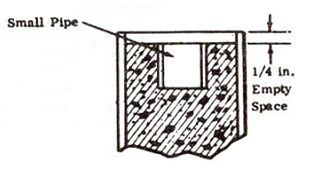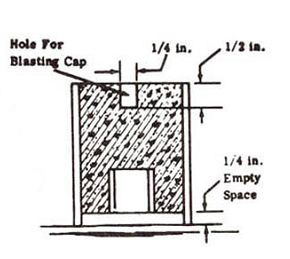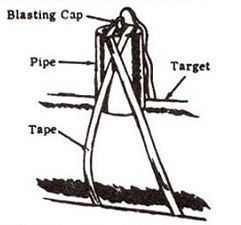Section II
No. 7
A shaped charge can be made from common pipe. It will penetrate 1-1 2 in. (3-1 “2 cm) of steel, producing a hole 1-1/2 in. (3-1/2 cm) in diameter.
MATERIAL REQUIRED:
- Iron or steel pipe. 2 to 2-1/2 in. (3 to 6-1/2 cm) in diameter and 3 to 4 in. (7-1. 2 to 10 cm) long
- Metal pipe, 1/2 to 3â4 in. (1-1/2 to 2 cm) in diameter and 1-1/2 in. (3-1 2 cm) long, open at both ends. (The wall of the pipe should be as thin as possible.)
- Blasting cap
- Non-metallic rod, 1/4 in. (6 mm) in diameter
- Plastic or castable explosive 2 metal cans of different sizes
- Stick or wire
- Heat source
PROCEDURE:
1. If plastic explosive is used
a.Place larger pipe on flat surface. Hand pack and tamp explosive into pipe. Leave approximately 1/4 in. (G mm) space at top.
b.Push rod into center of explosive. Enlarge hole in explosive to diameter and length of small pipe.
c.Insert small pipe into hole.
 IMPORTANT: Be sure direct contact is made between explosive and small pipe. Tamp explosive around pipe by hand if necessary.
IMPORTANT: Be sure direct contact is made between explosive and small pipe. Tamp explosive around pipe by hand if necessary.
d. Make sure that there it 1/4 in. (6 mm) empty space above smell pipe. Remove explosive If necessary.
e.Turn pipe upside down and push rod 1/2 In. (1-1/4 cm) into center of opposite end of exploelve to form a hole for the blasting cap.
CAUTION: Do not insert blasting cap in hole until ready to fire shaped charge.
2. If TNT or other castable explosive is used:
a. Follow procedure, Section U, No. 3, Step 4, Parts a, b, c, including CAUTIONS.
b. When all the explosive has melted, remove the inner container and stir the molten explosive until it begins to thicken.
c. Place large pipe on flat surface. Pour explosive into pipe until it is 1-3/4 In. (4 cm) from the top.
 d.Place small pipe in center of large pipe so that it rests on top of explosive. Holding small pipe in place, pour explosive around small pipe until explosive is 1/4 In. (6 mm) from top of large pipe.
d.Place small pipe in center of large pipe so that it rests on top of explosive. Holding small pipe in place, pour explosive around small pipe until explosive is 1/4 In. (6 mm) from top of large pipe.
 e. Allow explosive to cool. Break crust that forms on top of the charge during cooling with a wooden stick and add more explosive. Do this as often as necessary until explosive Is 1/4 In. (6 mm) from top.
e. Allow explosive to cool. Break crust that forms on top of the charge during cooling with a wooden stick and add more explosive. Do this as often as necessary until explosive Is 1/4 In. (6 mm) from top.
f. When explosive hat completely hardened, turn pipe upside down and bore a hole (or the blasting cap In the middle of the top of the charge about 1/2 In. (1-1/4 cm) deep.
HOW TO USE:
Method I - If electrical blasting cap is used:
1. Place blasting cap in hole made for it.
CAUTION: Do not insert blasting cap until charge Is ready to fire.
2. Place other end of pipe flush against the target. Fasten pipe to target by any convenient means, such as by placing tape or string around target and top of pipe, if target is not flat and horizontal.
CAUTION: Be sure that base of pipe is flush against target and there is nothing between the target and the base of the pipe.
3. Connect leads from blasting cap to firing circuit.
Method II : If non-electrical blasting cap is used:
1. Crimp cap around fuse.
CAUTION: Be sure fuse Is long enough to provide s safe delay.
2. Follow Steps 1, 2. and CAUTION of Method 1.
3. Light fuse when ready-to fire.



